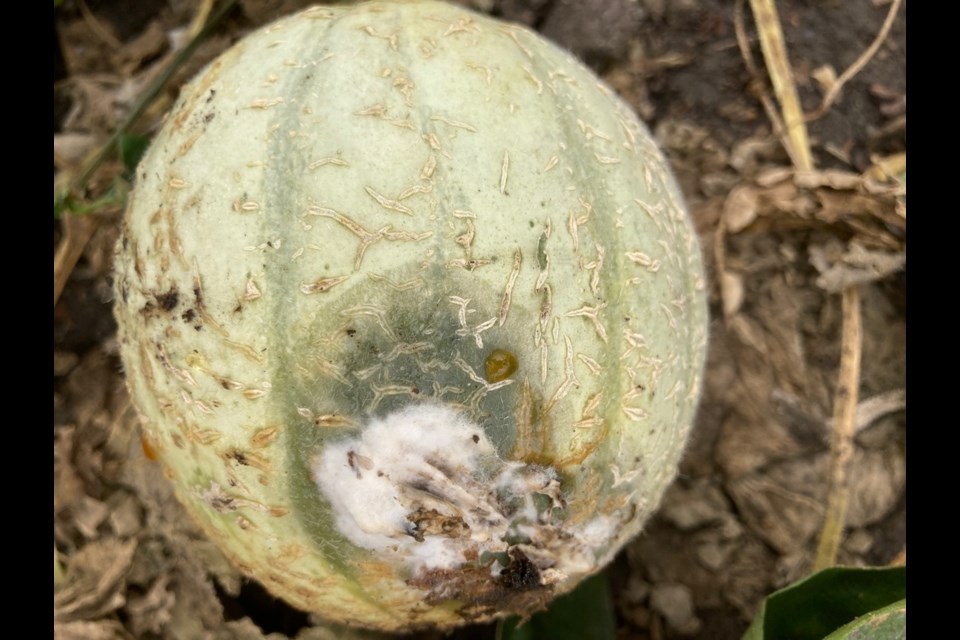Whether the fruit is used for attractive fall displays, making pumpkin pies for Thanksgiving or carving for Halloween, October is pumpkin month. Our family enjoys both the pumpkins we grow ourselves as well as an annual shopping expedition to the pick-your-own pumpkin at the vegetable farms close to the city.
Pumpkins can be attacked by a ubiquitous fungus called Sclerotinia sclerotiorum, which can rot the whole pumpkin. Many pathogens are very selective about the plants they attack, for example, rusts and mildew have different species that attack specific plant types. However, Sclerotinia can attack a wide range of hosts, including vegetables (carrots, parsnips, beans, celery), fruits (tomatoes, pumpkins), flowers (sunflowers), herbs (caraway, coriander) and crops (canola).
The diseases caused by Sclerotinia are often called cottony rot or white mould, because of the white fungal growth that envelopes the host, or stem rot and blossom blight because of the parts of the plant being attacked. The first sign of infection is usually the surface growth of white, fluffy mycelium (fungal strands), and the breakdown of the plant tissues under the fungal mat. A soft rot of the plant tissues may develop as the fungus releases enzymes that break down the plant tissues, enabling the fungus to absorb nutrients from the infected plant. As the disease progresses hard, black resting structures called sclerotia develop on the mould. When stems are first infected, the foliage above the infection may appear normal, but once the stem is completely rotted the upper part of the plant dies quickly and sclerotia will form inside the stems. These sclerotia usually take on the shape of the cavity in which they are growing. This is typically seen in canola and sunflowers. In a field crop like canola, the sclerotia fall to the ground when the crop is swathed and incorporated into the soil. This provides a continuing cycle for the pathogen. After the winter, and for at least 2-4 years hence, the sclerotia produce tiny, mushroom-like structures called apothecia, that release puffs of airborne spores when air currents pass over them. The small, colourless spores can travel several kilometres on wind currents, and their release is usually timed to cause infection of new crops. Weedy species, such as thistles, may also be infected and help continue the disease cycle.
When underground crops like carrots and parsnips are infected by the mycelium in the soil, the initial infection may not be noticeable but once the vegetables are placed in a cool, moist environment for storage, large pockets of infection can spread from root to root, causing extensive losses. We store our carrots in ventilated plastic bags and inspect them every few months for signs of infection. Removal of all damaged roots and re-bagging of healthy carrots is necessary. If you suspect high infection rates, rinse root crops, like carrots, in a dilute bleach solution to reduce the spread of disease. This year I have noticed early infections on tomatoes and melons lying on the soil surface in a drip-irrigated area. I will be keeping a watchful eye on my stored vegetables.
Canola and commercial vegetable producers often spray fungicides on their crops, to prevent, or reduce, disease. Home gardeners can help reduce disease by reducing humidity in the garden by spacing plants to avoid touching each other. As soon as there is any evidence of infection, remove plants immediately to help prevent spread to other plants. Careful monitoring of stored vegetables is necessary, particularly if Sclerotinia has been observed in crops before harvest.
If ever someone writes a horror story about a fungus that mutates and becomes a major problem for humans, turning them into white, ghost-like specimens covered in mould, then Sclerotinia would be the most likely candidate. A long time ago, on an exam paper, I asked students what their favourite pathogen was and why. The response I have always remembered was from a student who chose Sclerotinia, “because the infection it causes is like a car wreck. You know you shouldn’t look but you can’t resist it.” And that does sum up nicely the damage this fungus can cause.
Jill Thomson is a retired Plant Pathologist who lives in Saskatoon, where she enjoys gardening with her family, including the dogs.
This column is provided courtesy of the Saskatchewan Perennial Society (SPS; [email protected]). Check our website (www.saskperennial.ca) or Facebook page (www.facebook.com/saskperennial) for a list of upcoming gardening events.
Bookmark SASKTODAY.ca, Saskatchewan's home page, at this link.




